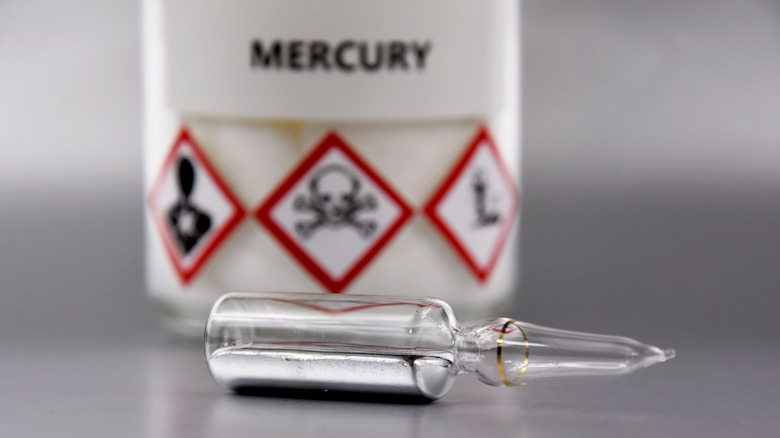What Does Mercury Do To The Body?
Many people first learn about mercury in school and know it as the red liquid found in a thermometer. Two facts usually follow: First, that mercury itself is toxic, and second, that because of this modern thermometers don't actually contain mercury anymore.
The toxicity of mercury is undeniable. If absorbed by pregnant women, the element can adversely affect fetuses in the womb, leading to health issues such as cognitive impairment, which affects the offspring after birth. Cognitive damage can also occur in children and adults that are exposed to high levels of mercury or the compound methylmercury, which can induce tremors, headaches, neurological disorders, and reduce brain function. Mercury and its compounds can also cause serious damage to the lungs, stomach, liver, and kidneys — as well as the skin and eyes via direct contact.
Nevertheless, people have long been drawn to mercury for its strange chemical properties, and in some cases have even injected the harmful element hoping for miraculous health benefits.
Quicksilver, the mystical name for mercury
Though toxic, mercury has seemingly been used by humans across numerous cultures for thousands of years. It appears naturally in many forms and was used by ancient peoples to form skin creams and cosmetics. Other uses include paint — mercury was found in the pigments of artworks in Roman homes mummified by the eruption of Vesuvius in A.D. 79.
But mercury is generally most closely associated with alchemy, the mystical practice of attempting to fabricate solid gold from base metals and attempting to cure illnesses and — alchemists believed — achieve immortality. Along with sulfur, mercury received special attention from alchemists as it has the propensity to interact with many other metals in ways that suggested mystical properties. Used by alchemists since before 300 B.C., it was otherwise known as "quicksilver."
In China, there was a long history going back over 2,000 years of rich dynasties employing alchemists to develop elixirs of immortality. A great many of these potions contained mercury in some form and are believed to have possibly led to the premature deaths of many alchemists — as well as the Qin Dynasty founder Emperor Qin Shi Huang, who died at the age of 49 after drinking a supposed immortality elixir.
Toxic medicine and mad hatters
While alchemists turned to mercury as a potential wonder material in their crusade to turn base metals into precious gold, in later centuries others attempted to use the toxic element to create a cure for one of history's deadliest diseases: syphilis. The disease, which is sexually transmitted and became an epidemic in Europe at the turn of the 15th century, caused countless deaths due to a lack of immunity among the general population. With the disease particularly prevalent among the military forces of the day — and often being the undoing of many leaders' battle plans — the race was on to find a cure for syphilis. A range of mercury treatments was developed in both pill and cream form — both of which were bogus. It took until the 20th century for effective treatments for the disease to be developed in the form of the arsenic derivative arsphenamine and later the antibiotic penicillin.
The effect of mercury on the brain is a central joke in the subtext of one famous character from children's literature: The Mad Hatter from Lewis Carroll's "Alice's Adventures in Wonderland." For centuries, mercury was a crucial material in the hatmaker's art, the use of which would give the craftsperson a range of neurological issues such as slurred speech and brain fog. The phrase "mad as a hatter" makes reference to this, with mercury exposure underpinning the erratic behavior of Carroll's Hatter.
Can you get mercury poisoning today?
Instances of mercury poisoning in the present day are vanishingly small compared to the levels experienced by previous societies using the chemical, ignorant of the risks it poses. Nevertheless, government bodies charged with managing public health offer advice on avoiding mercury poisoning, which can occur in certain ways.
The most commonly cited source of mercury that might affect people today is found in edible fish. Though considered a rare element, mercury occurs naturally in underwater sediment and makes its way into fish through gill absorption or through underwater feeding. Over the last century, human activity — such as the burning of fossil fuels and mining — has contributed to the amount of mercury in the atmosphere and water. The eating of fish with a high mercury content can be harmful, especially to pregnant women and small children. King mackerel, swordfish, and shark all contain such high levels of mercury that the California Office of Environmental Health Hazard Assessment recommends that people avoid eating such species altogether.
Fish, however, is known apart from its mercury content to be a healthy part of a balanced diet, with health benefits coming from the omega-3 fatty acids that many fish species contain. Many health advisory boards note that, in general, the smaller the fish, the lower the levels of mercury found within them. Sardines, salmon, and chub mackerel top the list of fish that contain the most health benefits without the mercury risk.



